Byzantine Coinage › Constantine I » Ancient origins
Articles and Definitions › Contents
- Byzantine Coinage › Antique Origins
- Constantine I › Who Was
Ancient civilizations › Historical and archaeological sites
Byzantine Coinage › Antique Origins
Definition and Origins
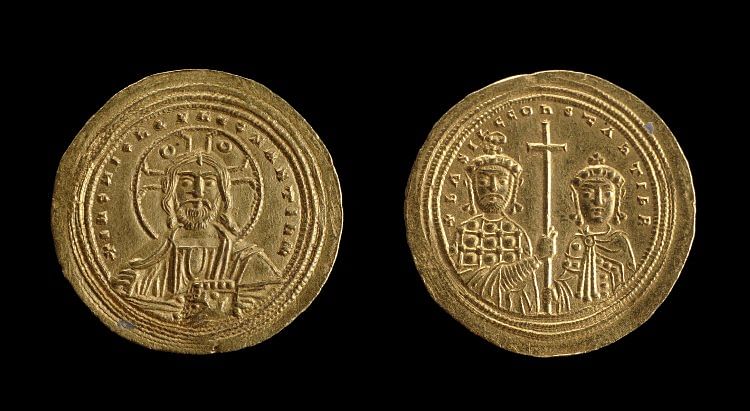
The coinage of the Byzantine Empire continued that of its more ancient predecessors and functioned as a convenient method of payment for goods and services, especially to soldiers and officials, and as a means for people to pay their taxes.Coins also continued to be the best way for a ruler to spread their image and remind their people who they owed their allegiance to. The star of the Byzantine purse was undoubtedly the gold solidus or nomisma. Introduced by Constantine I in the 4th century CE, it would reign supreme as the currency standard for 700 years, eventually to be replaced by the electrum hyperpyron from the 12th century CE.
THE NOMISMA AS STANDARD
Every Byzantine emperor minted their own coins, from either Constantinople, the capital, or in mints in major provinces such as Italy (Ravenna), Sicily ( Syracuse ), Anatolia (Antioch), and North Africa ( Carthage and Alexandria ). As in the ancient world, the value of coins in Byzantium depended on their weight and the purity of the metal used to produce them.The main coin of the Byzantine empire for 700 years was the solid gold nomisma or solidus in Latin. On its introduction in the East in 312 CE by emperor Constantine I (r. 306-337 CE), 72 nomismata were equal to one pound of gold. Thus, each example weighed 4.4 grams of pure gold and measured between 21 and 22 mm in diameter. The first versions carried a portrait of Constantine on the obverse (front) and Roman army standards on the reverse side. Further currency reforms were carried out by Anastasius I (r. 491-518 CE) whose reign actually marks the beginning of Byzantine coinage proper for numismatists.
Such was the nomisma’s longevity and reliability - Basil II was still minting them in the 1020s CE - that the worth of all other lesser-value coins made of gold, silver, or copper was measured against it. For example, the gold semissis was equal to half a nomisma, while three gold tremissis coins were worth one nomisma. Both of these coins would still be in circulation in the late 9th century CE.
ONE NOMISMA COULD HAVE BOUGHT YOU A PIG, THREE WERE NEEDED FOR A DONKEY, & FIFTEEN WAS THE PRICE OF A CAMEL.
The most common silver coin was the miliaresion, introduced in 720 CE, twelve of which were worth one nomisma. The most common copper coin was the large follis, introduced by Anastasios I (r. 491-518 CE) to improve the poor quality coins of previous emperors, which was worth very little but was useful for small transactions: 24 folles were equal to one miliaresionwhile a whopping 288 were required in exchange for a single nomisma. In terms of actual value, a labourer would have earned between five and twelve folles a day while a middle-ranking official earned some 1000 nomismata per year. One nomisma could have bought you a pig, three were needed for a donkey, fifteen was the price of a camel, and a slave with a few skills would have set you back 30 gold coins - a purchase to be made with care, clearly. Aristocrats measured their wealth in the thousands of nomismata while in the rare cases where a field army's four-year treasure chest was stolen by the enemy, such as the Bulgars in 809 CE or the Arabs in 811 CE, we know that it consisted of 80-90,000 nomismata - enough to make a tax collector's eyes water.
DEVALUATIONS
The nomisma did face brief challenges to its dominance. In the 6th and 7th century CE a less pure gold coin (22 carats as opposed to 24) was minted but did not last. A more serious challenger came in the mid-10th century CE in the form of Nikephoros II Phokas' (r. 963-969 CE) attempt to save even more gold and produce more coins. He minted a gold coin, the tetarteron, which was not only 22 carats instead of pure gold but also with one-twelfth less weight than the nomisma. In the first half of the 11th century CE, Constantine VIII (r. 1025-1028 CE) and Michael IV (r. 1034-1041 CE) both nibbled at the nomisma itself and added 5% silver to eke out more bang for their buck. This was the beginning of a slippery slope towards a much-devalued currency.
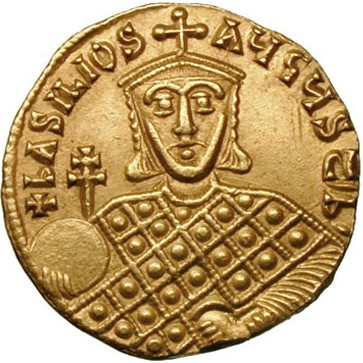
Basil I
It is debatable if emperors understood or not the long-term economic consequences of undermining their own currency, but they could not resist consistently tinkering with the gold content of their coins, reducing it when the state coffers were low and endangering confidence in the coin. Perhaps the practical necessity of the moment and the need to pay mercenary soldiers to defend the empire or make up for tax shortfalls when plagues hit the population took precedence over economic theory. As a consequence, over the whole of the 11th century CE, the gold content of the nomisma gradually went down in stages from 20 to 18 to 16 to 12 and ended up around 8 carats during the reign of Nikephoros III Votaneiates (r. 1078-1081 CE).
In the 10th century CE there were, in fact, six different versions of the nomisma in circulation and international merchants even began to favour Arab gold dinars. The state of the premier coin of the realm became so bad and prices were rising so quickly that reform was urgently needed. Consequently, Emperor Alexios I Komnenos (r. 1081-1118 CE) minted a new coin c. 1092 CE, the hyperpyron (meaning “highly refined”), which became the new standard, even if it was actually made from electrum (an alloy of gold and silver) and worth only a third of the nomisma. Alexios had sorted out the currency confusion of nobody knowing quite what the equivalents of all the coins in circulation were, but he also, rather astutely, managed to quadruple tax rates in the process. The hyperpyron did take a few decades to take off and, like the nomisma, it occasionally suffered a debasement, notably during the reign of Michael VIII (r. 1259-1282 CE), but it would survive until the fall of the empire in the 15th century CE.
IMAGERY
Coins were spread far and wide thanks to merchants and travellers so they could be used to good effect as a useful means of propaganda by rulers eager to extend their power and fame into every corner of the empire and to its neighbours. Portraits were conventionalised and did not approach the realism of, say, ancient Hellenistic or Roman coins. They usually show the person front on rather than in profile and holding a cross, sword, or sceptre. The name is helpfully written, too, which is just as well given the often poor likenesses of the time.
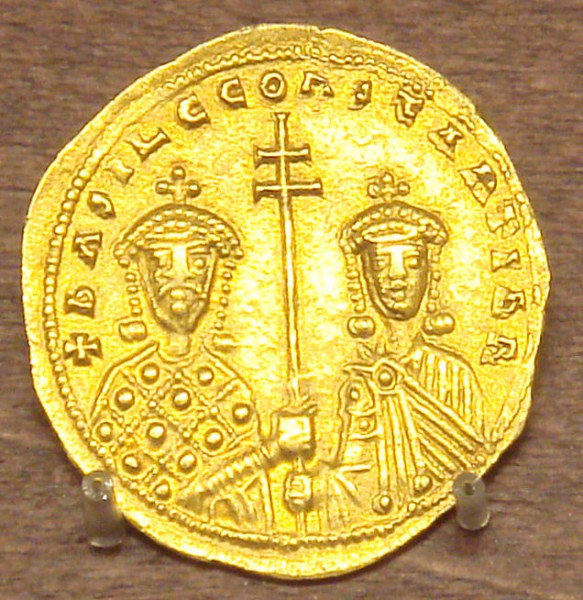
Coin of Basil II
Not only could the emperor or empress put their own face on the front of the coin - Empress Irene (r. 797-802 CE) went one better and put herself on both sides - but they could reinforce their message with other symbols of imperial power on the back.Short legends were first written in Latin, then in Latin and Greek, and then wholly in Greek from the 7th century CE.Constantine I often used the Tyche of Constantinople on the reverse of his coins. A symbol of good fortune, she sits on a throne, wears a crown with battlements and holds a cornucopia. The cross of Christianity and the Christogram became a favourite choice for many subsequent emperors. The Virgin or saints frequently appear while the coins of Alexander (r. 912-913 CE) have John the Baptist being crowned by the emperor.
JUSTINIAN II (R. 685-695 CE) WAS THE FIRST EMPEROR TO SHOW JESUS CHRIST ON COINS C. 691 CE.
Justinian II (r. 685-695 CE) had been the first emperor to show Jesus Christ on coins c. 691 CE along with the legend rexregnantium (“King of kings”). There were two versions of Jesus, one with a beard and one without, and they are similar to surviving mosaic portraits. Perhaps it is no coincidence that this pious emperor insisted that the Arab caliphate pay their tribute with these coins (which they refused and, in response to the affront, successfully invaded Anatolia to boot). By the mid-9th century CE Christ was regularly shown on the obverse of coins with the legend “Jesus Christ, King of those who rule.” The reverse sides of these coins showed the emperor being crowned by Christ, the Virgin, or a particular saint, and so reminded people that he or she was God's representative on earth.
Coin portraits were also used for political endorsements, especially when emperors had selected their chosen heir and wished to avoid a messy succession dispute after their own death. The child was often crowned as co-emperor and shown as such on coins, side by side with their parent or on the reverse side, sometimes with a sibling alongside.
CIRCULATION
For most people, the copper and silver denominations of coins would have been the only ones they handled on a daily basis.Those lucky enough to have a shiny gold nomisma in their palm probably did not keep it for very long as one of the main reasons for the state to mint coins in the first place, besides to pay soldiers and officials, was to more easily collect taxes.There were basic and ever-present taxes on land and persons/households, besides any other ingenious excuse the tax authority could come up with, such as a levy on any slave imported from a particular region. Further, all taxes had to be paid in gold coins, which was probably why the state was so vigorous in ensuring their quality.
In fact, the minting of nomisma coins was so carefully monitored and their gold content checked so scrupulously by the state that their reliability ensured even foreign states accepted and used them. The 6th-century CE merchant Cosmas Indicopleustes noted,
…every nation conducts its commerce with their nomisma, which is acceptable in every place from one end of the earth to the other…In no other nation does such a thing exist.(Herrin, 322)
The scarcity of foreign coins excavated at Constantinople is further evidence that only one coinage dominated the imperial economy. The Arab caliphate, getting over its initial dislike of the coin, was one notable user of the nomisma, where it was known as the bezant. Usually preferring it to minting their own gold coinage, they did sometimes produce their own coins which imitated, right down to the legends, those of Byzantium. Viking kings were also partial to Byzantine gold, and many coin hoards have been found across Scandinavia and northern Europe. Byzantine coins have turned up in such far-flung places as Russia, Persia, and Sri Lanka. From the 4th until the 11th century CE, and probably beyond, the nomisma was, then, the international coin of the day, and it has rightly earned from historians the unofficial title of the “dollar of the Middle Ages.”
Constantine I › Who Was
Definition and Origins
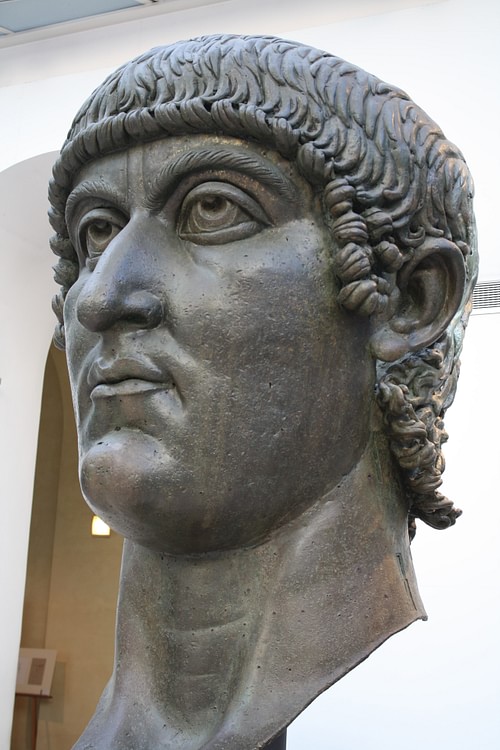
Constantine I was Roman emperor from 306 to 337 CE. Realizing that the Roman Empire was too large for one man to adequately rule, Emperor Diocletian (284-305 CE) split the empire into two, creating a tetrachy or rule of four. While he ruled the east from Nicomedia as an “ augustus ” with Galerius as his “ caesar,” Maximian and Constantius the Pale ruled the west. It was the son of Constantius, Constantine, who would one day rise to defeat all challengers to the throne and reunite the split empire, moving the capital away from Old Rome and build a new capital, a capital that one day would bear his name, Constantinople.
EARLY LIFE
Although sources vary on the exact year of his birth, Constantine (Gaius Flavis Valerius Constantinus) was born at Naissus in present day Serbia as early as 272 CE or as late as 285 CE. Since his father was not only a military commander but also the caesar of the west, Constantine lived his entire early life in the imperial court, eventually serving as a high ranking staff officer for Diocletian. Even in his youth, those around him saw Constantine as a man of boundless energy. Under the emperor's tutelage, he learned that a ruler's job was to defend the empire from any external force and create a just and ordered society - something Constantine would put into practice when he became emperor himself.
In May of 305 CE Diocletian and Maximian both abdicated their thrones to Galerius in the east (with Maximinus Daia as caesar) and Constantius in the west (with Falvius Valerius Servius as caesar). These appointments were not popular with everyone. Maxentius, the son of Maximian, and Constantine felt betrayed, each believing he deserved the appointment as caesar. This omission would not be forgotten and would eventually lead to a long, bitterly fought battle over control of both halves of the empire. After Diocletian abdicated, Galerius (in an attempt to appease bitter feelings) permitted the disappointed Constantine to return to the west in 306 CE to serve under his father. Before Constantius succumbed to leukemia (the reason he was called “the Pale”) in July of 306 CE at York, Constantine had the opportunity to campaign with his father in Britainagainst the Picts. It was in Britain that the newly appointed augustus earned the title “Britannicus Maximus” for the second time.
AFTER HIS FATHER'S DEATH CONSTANTINE CONTINUED TO BUILD A REPUTATION AS A MAN CAPABLE OF RAPID AND DECISIVE ACTION.
After his father's death Constantine continued to build a reputation as a man capable of rapid and decisive action when in 307 CE he attacked the Franks. It was here that he proved he could act without mercy when he killed two Frankish kings by throwing them to beasts in the amphitheatre at Trier. However, he could also show compassion as when he restored church property that had earlier been confiscated. Slowly he gained the respect of the army, demonstrating to his men, even those older and more experienced, they could trust him.
With the death of Constantius and the success of the war in Britain, many expected Constantine to be named the new augustus in the west; however, Severus (caesar and close friend of Galerius) was promoted to the position, despite the claim that Constantius had named his son as augustus on his deathbed. Regardless of the official decree, Constantine was declared augustus by his men. Galerius, however, refused to recognize this declaration, naming himself caesar instead. Not to be overlooked, Maxentius, who had also been overlooked in 305 CE, ignored both Galerius and Constantine and declared himself augustus in October of 307 CE. With the support of the people of Rome and the Praetorian Guard, he controlled Sicily, Corsica, Sardinia, and parts of North Africa. Eventually, as many as six different people would eventually claim control in the west.
Because of his friendship to Galerius, Severus was distrusted by both Constantine and Constantine's brother-in-law Maxentius, and in order to defeat the new augustus, they allied themselves with the former augustus Maximian and joined forces against Severus. Unfortunately for Severus, who had received orders to stop Maxentius, his army deserted him (having been bribed by Maxentius). Fearing for his life, he fled to Ravenna, only to be captured and killed outside Rome. His death prompted Galerius to unsuccessfully invade the west with an army. In 308 CE a new tetrachy was formed (with the advice of Diocletian) with Licinius (an Illyrian army officer and friend of Galerius) as the new augustus and Constantine retaining his position as the caesar. To add to the confusion, Maximian (who had been living at Constantine's court as an advisor) came out of retirement in 310 CE, announcing himself as the new augustus, claiming Constantine was dead. Constantine, who had been away fighting the Franks, hunted him down outside Marseilles (the city had refused to grant him assistance), and in desperation Maximian hanged himself.
Meanwhile, Maxentius's tenure in Rome was waning. He had lost his popularity with the citizens of Rome - overtaxing them in order to build a new basilica and a large statue of himself. His contempt for the people had resulted in a series of riots which only ended with the massacre of several thousand Romans. Constantine waited patiently and watched as the empire in the west began to self-destruct then, gathering an army of forty thousand, he crossed the Alps and invaded Italy.
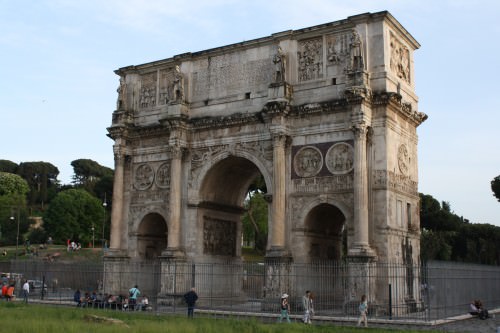
Arch of Constantine I
CONSTANTINE BECOMES EMPEROR
With little support in the city, Maxentius left Rome to meet Constantine in one final, crucial battle - the Battle of Milvian Bridge in 312 CE. On the day before the battle began, Constantine reportedly looked to the sky where he saw the sign of the cross superimposed over the sun. Under it was the inscription In Hoc Signo Vinae or “ conquer by this sign.” That night, in a dream, he received an explanation of the sign - Christ appeared before him telling him to carry the sign of the cross into battle. The following day old banners were replaced with new ones displaying the sign of the cross. Although outnumbered, Constantine easily defeated Maxentius who fled back to Rome, however, before reaching the city, he fell into the river and drowned; his body was discovered the next morning among the corpses of many others. This victory is seen by historians as a turning point in history, a fusion of church and state. Constantine immediately assumed complete control of the west. As the new augustus in the west, he marched into Rome; one of his first acts was to issue the Edict of Milan, a toleration of all religions (it would later be co-signed by Licinius).
In the east Galerius and Maximinus Daia were serving as augustus and caesar. After Galerius died from cancer (on his deathbed he rescinded all anti-Christian edicts), Maximinus and Licinius fought for control of the east, eventually splitting that part of the empire between them - Licinius got the Balkans while Maximinus got Asia Minor and the eastern provinces. This arrangement was not to last and in 313 CE the two fought on the plains of Thrace. Like Constantine at Milvian Bridge, Licinius fought under the sign of the cross; however, he did it not because of his faith but only to gain the support of the Christians; his opponent, Maximinus, had promised to eradicate them. Despite inferior numbers, Licinius was victorious, and after the suicide of Maximinus, seized control of the east. To be safe and secure in his right to the throne, he immediately executed the sons of both Galerius and Severus, the family of Maximinus, and even Diocletian's daughter.
An uneasy truce existed between Licinius and Constantine, partially because Licinius had married Constantine's half-sister Constantia. In their first meeting on the battlefield In October of 316 CE Constantine defeated him at Cibalae. A second battle near Hadrianopolis ended with land cessions in the Balkans to Constantine. Over the next few years, Licinius's attitude towards the Christians changed with both executions and the destruction of several Christian churches. This was enough to prompt Constantine to gather an army and defeat Licinius in a second battle at Hadrianopolis. The defeated commander fled the battlefield, escaping against the Bosporus. In September of 324 CE Licinius was finally defeated at Chrysopolis and surrendered. Licinius hoped to return to life as a private citizen which Constantine initially granted, but he went back on his word, and Licinius was hanged in 325 CE - even his nine-year-old son was killed. Constantine's victory would reunite the empire.
BYZANTIUM
The fifty-two year old Constantine was now the sole emperor of the empire and with it a sense of stability returned.Constantine realized that Old Rome was not the city he wanted for a capital, and despite several of the building projects he instituted, it was decaying. Rome was no longer practical (Constantine even disbanded the Praetorian Guard), and Nicomedia was never considered, for it had been the capital of Diocletian. A new capital was needed, and although he thought about the site of ancient Troy, Constantine finally saw what he wanted - Byzantium. The ancient city was strategically located on the European side of the Strait of Bosporus, so it would control traffic to and from the Black Sea. It also provided an excellent harbor (The Golden Horn) and, therefore, could be easily defended.
To rebuild the city into the one in his vision, he brought in artisans and resources from across the empire. There were wide avenues with statues of Alexander, Caesar, Augustus, Diocletian, and of course, Constantine. He rebuilt the walls, built cisterns, Christian churches (Hagia Irene) and pagan temples. It was a city that remained classical yet inspired by a Christian god. In 330 CE the city was finally dedicated.
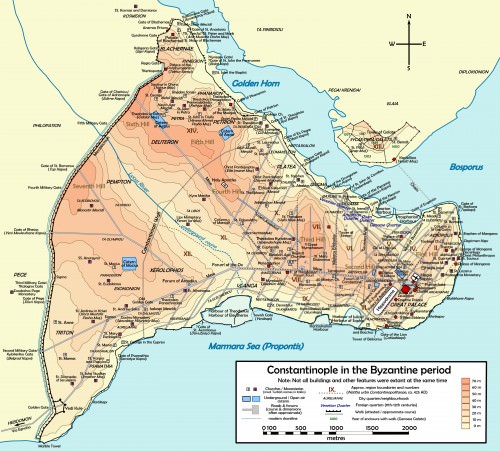
Map of Byzantine Constantinople
CONSTANTINE & CHRISTIANITY
During his years of warfare in the west he had always demonstrated religious tolerance with both pagans and Christians (he claimed to be a Christian since 312 CE). His mother Helena was a devout Christian, and after Constantine became emperor, he sent her on a pilgrimage to the Holy Land where she had built the Church of the Nativity at Bethlehem. Although he had been a worshipper of the sun-god in his youth and while some claim he did not become baptized until his deathbed, he still gave every indication that he was a devoted Christian. He is even credited by many historians with making Christianity the official religion of the empire (although others credit Emperor Theodosius), despite the fact that pagan symbols of Sol Invictus and Mars appeared on his coins. While he tolerated certain pagan religious practices, pagan sacrifices were forbidden, templetreasures seized, gladiatorial contests ended (Christians disliked them), crucifixions were abolished, and laws were enacted against sexual immorality and ritual prostitution.
In 325 CE Constantine invited clerics from across the empire to a conference at Nicaea where he made a plea for unity. The result of the conference was not only a condemnation of Arianism but also the Nicene Creed, a definition of what it meant to be a Christian. One year later, in 326 CE, Constantine had his religious faith tested when he had his own son Crispus (from his first wife Minervina) killed - falsely accused of adultery. According to sources, Constantine's second wife Fausta made the accusations against Crispus, who had fought beside his father and governed the western provinces, because she was in love with him but he had rejected her. She later committed suicide when it was proven that the accusations were false. Constantine regretted the action for the remainder of his life.
DEATH
Constantine maintained his role as a military commander, fighting the Alemani in 328 CE with the assistance of his son Constantius II, defeating the Goths in 332 CE by starving them into submission, and lastly, capturing lost territories from the Dacians (territories that were later lost after his death). His last wish was to conquer neighbouring Persia after their king Shapur II had invaded Armenia. However, it was not to be. In 337 CE Constantine fell ill and died. He had ruled for thirty-one years. He was buried at the Church of the Holy Apostles in Constantinople, leaving his empire in the hands of his three sons - Constantine II, Constantius II, and Constans with Constantius II eventually defeating his brothers and ruling the entire empire by himself.
LICENSE:
Article based on information obtained from these sources:with permission from the Website Ancient History Encyclopedia
Content is available under License Creative Commons: Attribution-NonCommercial-ShareAlike 3.0 Unported. CC-BY-NC-SA License